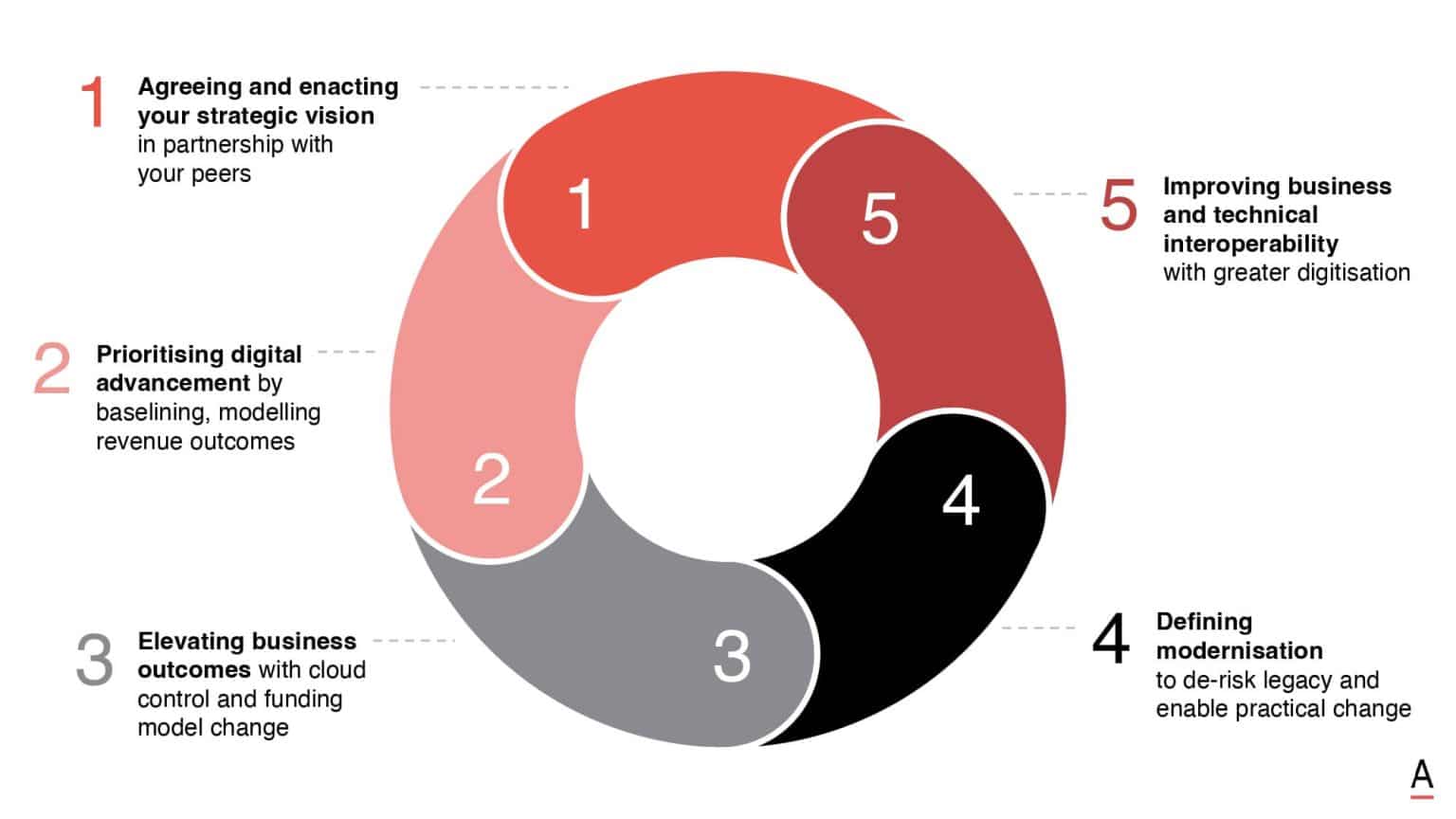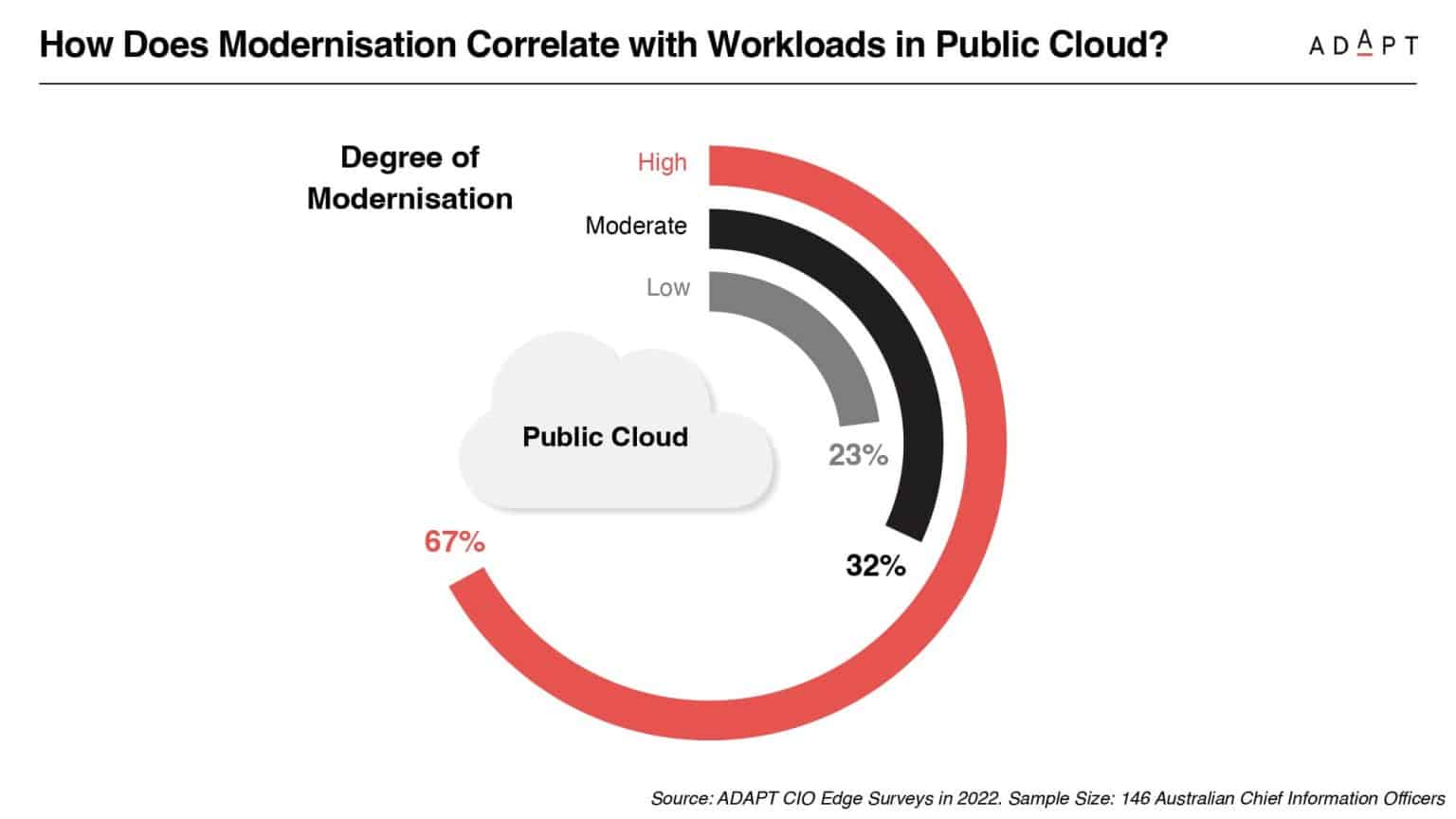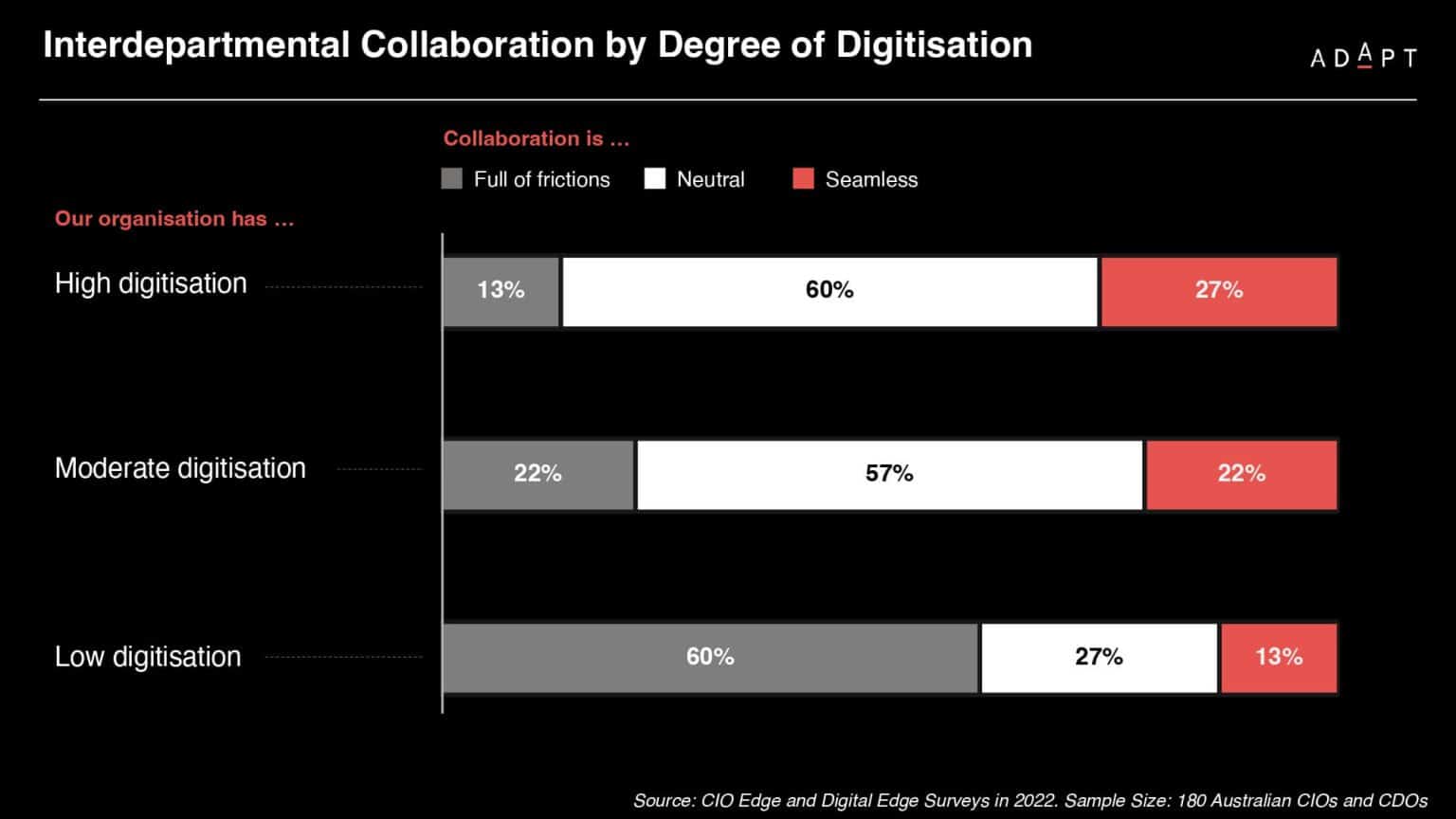5 Practices that Will Lead to Value Capture
ADAPT unveils insights for Australian CIOs to navigate digital challenges, collaborate on vision, and drive transformation.
In the dynamic realm of Australian business, CIOs play a pivotal role in orchestrating change and steering digital evolution.
This report distils actionable insights and best practices from an extensive study involving business executives.
By revealing prevalent barriers to change, like priority conflicts, talent shortages, and legacy issues, this strategic guide advocates for a collaborative approach within the executive leadership team.
Its goal is to forge a shared vision, unlocking aligned investments for sustained organisational progress.
Embark on an insightful journey with us as we explore innovative approaches to unleash organisational potential and adeptly navigate the intricacies of the digital realm.
ADAPT’s Research and Advisory clients can access the full report: Stop Sweating the Small Stuff with the Strategies that will Lead to Value.
1. Align and implement your strategic vision collaboratively

ADAPT regularly surveys Australian business executives, with the 2022 research involving 750 executives exposing prevalent barriers to change.
The top challenges identified include priority conflicts, talent shortages, and persistent legacy issues.
Transforming these common hurdles into opportunities requires establishing deeper partnerships within the executive leadership team.
This collaboration aims to formulate a shared vision and prioritise actions, aligning investments with desired outcomes for consistent organisational progress.
Action Steps:
- Enhance the Competitive Edge of Technology and Strategy Integration:
Delve into the intersection of technology and strategy to deepen strategic and tactical success. Engage with executive peers to understand their perspectives on leveraging technology for a competitive advantage.
Examine disruptive and optimising forces within your organisation, linking commercial insights with critical barriers faced by peers to highlight the returns achievable by addressing these risks.
- Adapt Strategies According to Individual Needs:
Integrate flexibility into strategies to accommodate experimentation and tailor development based on the unique needs of each person.
By pursuing a unified platform, provide choices for executives, employees, and customers.
Measure the value of this coordinated flexibility in driving changes in operating models, technical enablement, and facilitating rapid learning within the workforce.
- Foster Agreements for Ongoing Progress and Partnerships:
Maintain momentum in strategic and tactical initiatives by seeking continual improvements.
Adopt a continuous change approach to cultivate a culture that maximises the benefits of these transformations.
Establish agreements with employees and executives, aligning the purpose of strategies with employee roles and customer needs.
Explore these practices further in a ADAPT Case Study published in December 2022.
2. Propel digital progression through baseline analysis and revenue modeling

In digital transformation, and ADAPT Technology Trends report from October 2022 illuminates a robust connection between digitisation and revenue, as highlighted above.+
For instance, organisations adept at digitising operations and customer journeys secures a remarkable 35% of their revenues from innovation, marking a substantial 75% increase compared to those with inefficient digitisation.
Additionally, effective digitisation correlates with a 36% enhancement in revenues from cross-selling and a notable 19% upswing in sales through digital channels.
However, the correlation between digitisation and revenue from ecosystems, as explored in the final practice, needs to be more evident.
Action Steps:
- Evaluate Your Digital Factory for Future Performance:
Initiate the evaluation process by establishing a baseline for predicting future performance.
Scrutinise the outcomes of your digital factory, encompassing processes, tools, and skills improvements, in terms of revenues derived from innovation, cross-selling, and digital channels.
Utilise measurements of proceeds and payments associated with simplifying, automating, and connecting these journeys to model and prioritise subsequent transformation stages.
Further insights on these opportunities are explored in a ADAPT Market Trends report published in November 2022.
- Define the Value-at-Risk and Disruptive Potential of Maturing Digitisation:
Challenge the value-at-risk in the current and upcoming fiscal year.
While abandoning speculative bets on unproven technologies makes sense, discarding rapid returns from successful digital pilots is counterintuitive.
Refer to ADAPT’s Top Emerging Technology and Value Priorities for 2023 to contest proven investments that capture significant value.
Leverage this approach to optimise costs, reduce time-to-serve, and capitalise on the exponential value when sales to customers necessitate minimal or no human intervention.
- Align Strategies with CHRO and CFO:
Connect technology strategy with people and financial strategies to drive change.
Collaborate with the Chief HR Officer (CHRO) on learning and development initiatives for the swift adoption of reimagined workflows—partner with the Chief Financial Officer (CFO) to reallocate savings to these efforts.
Further insights on these collaborations are detailed in a ADAPT Best Practices report published in July 2021.
This alignment enables the mitigation of persistent hiring challenges and addresses escalating economic risks through strategic engagements.
3. Navigate cloud control and evolve funding strategies strategically

Elevating business outcomes through cloud control and funding model transformation is a multifaceted journey guided by strategic shifts and tactical considerations.
In the backdrop of insights gleaned from October 2022 ADAPT Technology Trends report, this evolution involves a dynamic interplay of IT modernisation, public cloud adoption, and funding model dynamics.
Action Steps:
- Explore Funding Model Transformation:
Delve into the intricate relationship between public cloud adoption and IT modernisation, recognising the advantages for highly modernised organisations in supplying IT services and fostering business growth.
- Address the Funding Paradox:
Confront the paradox where highly modernised organisations allocate more to operating expenses (OpEx) while less updated counterparts grapple with ongoing legacy expenses hindering modernisation.
This highlights the need for strategic solutions.
- Champion Improved Connectivity:
Advocate for improved connectivity across the organisation, particularly within the product council.
Collaborate with product, finance, and technology leaders to reshape funding dynamics, ensuring shared ownership and prioritised principles for dynamic funding.
Explore these engagements in the detailed ADAPT Case Study from August 2022.
- Explore Sustainable Funding Patterns:
Dive into sustainable patterns for dynamic funding adoption, involving a reevaluation of how finance supports IT strategy.
Prioritise consistency, flexibility, and transparency in sourcing and selling business outcomes.
Execute these designs before cloud migration to preempt future financial complexities.
Gain deeper insights in the ADAPT Best Practices report from June 2021.
- Sustain Cost Control for Emerging Opportunities:
Ensure ongoing cost control post-myth-busting and principal alignment.
Embrace cloud provider controls, seamlessly integrating them into delivery pipelines for financial assurance.
These controls guarantee financial stability and serve as a strategic guide for uncovering emerging business prospects.
For an in-depth exploration, refer to the ADAPT Case Study from August 2022.
This comprehensive approach empowers organisations to navigate the complex terrain of digital transformation, ensuring a resilient and adaptable foundation for future growth.
4. Define modernisation to de-risk legacy and drive practical change

In the preceding practice, we explored how modernized organisations effectively support their business objectives, emphasising the correlation between cloud modernisation and this transformative journey.
However, insights from ADAPT’s Cloud Migration Study, unveiled in September 2022, underscore a crucial point: public cloud services may not meet all demands.
Consequently, a strategic hybrid, multi-cloud approach becomes imperative.
By intentionally incorporating in-house, public, and private cloud solutions into their strategy, CIOs can successfully de-risk legacy systems, facilitate practical changes, and establish operating architectures that are both scalable and resilient.
Action Steps:
- Prioritise modernisation based on business criticality and urgency:
Align the modernisation of applications with business priorities by assessing criticality and the urgency for remediation.
Involve the product council in these decisions, considering both tactical (suitable for the immediate term) and strategic (fit for long-term purpose) treatments.
Evaluate these decisions based on a thorough analysis of costs and returns over three to five years.
- Define the role of each environment:
Initiate discussions about the function of each environment by prioritising business needs.
Leverage Edge for localised decision-making with quick access to essential information.
Opt for private cloud solutions to restructure and re-architect workloads, ensuring future readiness. Consider repurchasing commodity cloud services when their equivalence outweighs the cost of modernising legacy systems.
Retain in-house workloads that operate securely and efficiently and still possess significant residual life.
- Select the Right Treatment:
Tailor treatments for each workload, balancing urgent attention with long-term strategies.
This involves choosing the most suitable treatment for each application workload, considering factors like rebuilding, repurchasing, re-platforming, refactoring, or retaining based on the specific requirements and outcomes desired.
Explore more insights:
- Understand the strategic role of private cloud in an ADAPT Case Study, published January 2022.
- Delve into tactical (fine for now) versus strategic (fit for purpose) decisions in a ADAPT Case Study published in September 2022, specifically in the context of ‘born digital.’

5. Enhance business and technical integration through advanced digitisation
As illustrated below, building on the revenue gains discussed in the second practice, heightened process digitisation can yield substantial operational benefits.
Transitioning from low to moderate levels of digitisation has the potential to reduce operational friction by a factor of three.
Organisations achieving prominent levels of digitisation demonstrate a twofold increase in seamless collaboration compared to those at lower levels.
Additionally, enhanced digitisation correlates with increased value from customers and ecosystems.
However, despite these advantages, overall digitisation across organisations still needs to be revised.
Action Steps:
- Initiate with Operational Focus:
Concentrate initial efforts on operations to secure quick wins, emphasising process digitisation finance and human resources.
Engage functional leads for support, allowing the successful elements to scale and fostering improved business and technical interoperability.
Evaluate business interoperability through metrics like interdepartmental collaboration, detailed in the ADAPT Best Practices report from November 2022.
Assess technical interoperability by gauging the ease of moving workloads within hybrid, multi-cloud environments.
- Extend to Customer Experiences:
Progress in integrating and streamlining customer experiences by enhancing online interactions.
Extract more significant insights into customer needs and preferences, considering the inclusion of other business functions among your customer bases.
Utilises insights to prioritise transformative changes, as explored in a ADAPT Case Study published in April 2021.
- Expand Across Ecosystems:
Unpack the ecosystem opportunity by applying the lessons from operational and experience model changes.

Test and scale these changes by developing or participating in a connected customer ecosystem, as detailed in a ADAPT Case Study from August 2021.
As you scale these strategies, measure go-to-market enablement and customer engagement to identify growth opportunities and foster deeper partnerships, offering enhanced insights into customer abandonment.
Conclusion
CIOs are at the forefront of reshaping organisational landscapes.
By actively adopting these innovative strategies, they can navigate the digital currents and lead their organisations to uncharted heights in this era of profound technological evolution.
ADAPT’s Research and Advisory clients can access the full report: Stop Sweating the Small Stuff with the Strategies that will Lead to Value.
























